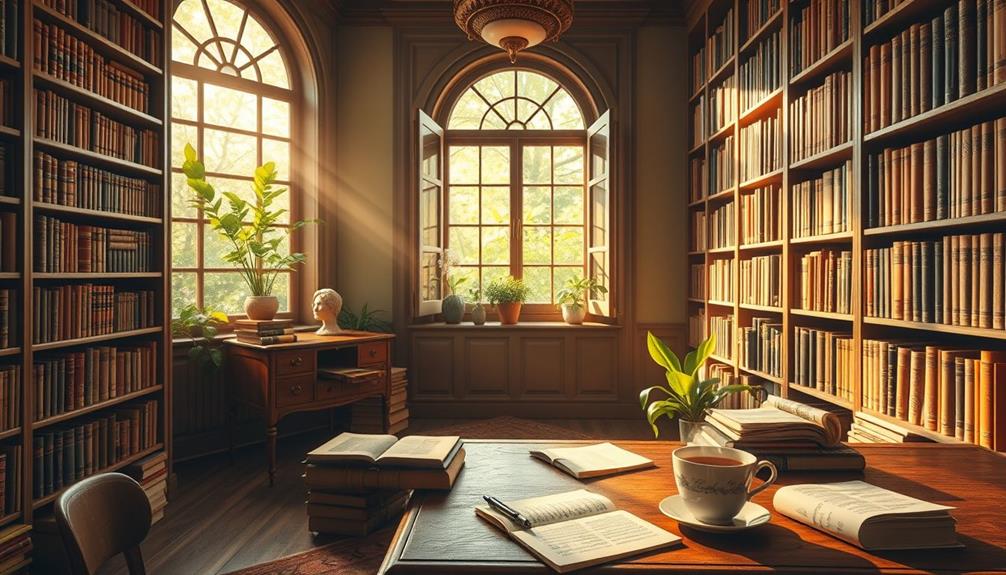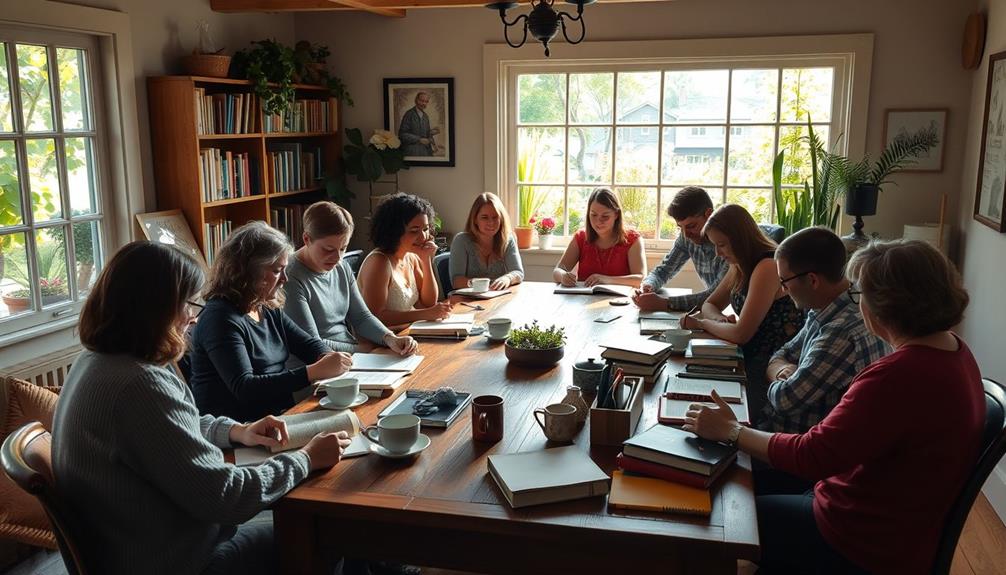Virginia Woolf's perspective on writing can ignite your creative spirit. She believed character is the heart of a novel, urging you to embrace authenticity in your narratives. Woolf emphasized that writing is tough work, comparing it to "heaving bricks over a wall," yet it's this labor that brings stories to life. Don't shy away from your emotional landscapes; they connect you with your readers. Let your imagination flow, drawing inspiration from everyday experiences. Remember, community support can spark new ideas and refine your work. If you're curious about her most inspiring quotes, there's much more to discover.
Key Takeaways
- Embrace the imperfections in your writing; it makes your narrative "clumsy yet alive," reflecting the authenticity of human experiences.
- Cultivate emotional depth in your characters, as they are the heart of your story and resonate with readers' feelings.
- Use personal narratives to establish a genuine connection with readers, highlighting universal themes that enhance empathy.
- Allow your imagination to flow freely; daily life can inspire extraordinary storytelling and unique perspectives.
- Engage with a supportive community for encouragement and constructive feedback, as collaboration can spark new creative breakthroughs.
Virginia Woolf's Writing Philosophy
Virginia Woolf's writing philosophy centers on the belief that character is the heart of any novel. She passionately advocates for the expression of character over didactic themes, insisting that authenticity in writing should mirror genuine human experiences.
For you as a writer, this means delving deep into the emotional landscapes of your characters, understanding their relationships, and revealing the complexities of their lives. Woolf's emphasis on the narrative's nuances resonates with the idea of star appeal and attractiveness, highlighting how characters can captivate readers through their charisma and emotional depth.
Woolf describes the novel's form as "clumsy yet alive," reflecting the dynamic nature of storytelling. This perspective encourages you to embrace the imperfections of your creative process.
Writing requires dedication; Woolf likens it to "heaving bricks over a wall," emphasizing the labor-intensive nature of crafting a compelling narrative.
The Essence of Personal Narratives

How can personal narratives transform the way we connect with readers? By delving into your own experiences, you can craft stories that resonate on a deeper emotional level.
Virginia Woolf believed that authenticity is key for writers, as it helps in creating compelling stories that reflect the complexities of human relationships. This is particularly relevant when exploring topics like navigating relationships with BPD, where personal insights can illuminate shared struggles and foster understanding.
When you embrace your unique stories, you enrich your creative process and invite readers to engage with your work more meaningfully.
Here are five ways personal narratives can enhance your writing:
- Authenticity: Being true to your experience fosters trust between you and your readers.
- Emotional Depth: Sharing genuine feelings allows readers to connect with your emotions.
- Universal Themes: Personal narratives can highlight shared human experiences that resonate widely.
- Unique Perspectives: Your individual journey adds richness and diversity to the literary landscape.
- Empathy Building: By presenting your own story, you encourage readers to empathize with others' experiences.
Incorporating these elements into your writing not only elevates your work but also deepens the connection with your audience, making your stories truly compelling.
Embracing Imagination in Writing

Imagination acts as the lifeblood of writing, allowing you to craft narratives that resonate with depth and complexity. Embracing your imagination is essential for releasing creativity and expressing the rich tapestry of human experiences.
By immersing yourself in the world around you, you draw inspiration from daily life, transforming ordinary moments into extraordinary storytelling. Engaging with past experiences, such as reviving old friendships, can provide unique perspectives that enrich your narratives.
Establishing a routine can nurture your creativity, providing a structured environment where your imaginative thoughts can flourish. Woolf believed that disciplined writing practices can enhance your ability to explore different personas, giving voice to characters that reflect the complexities of life.
This exploration of various identities can reveal new dimensions in your writing, making it more expressive and engaging. As you embrace imagination, remember that your experiences shape the stories you tell.
Engage deeply with your surroundings, and let those rich interactions fuel your creativity. Allow your imagination to guide you, weaving together elements of reality and fiction to create narratives that resonate with others.
The Journey of Literary Growth

Writing is a journey marked by continuous growth and exploration, where each experience shapes your narrative voice. Virginia Woolf's insights provide invaluable writing advice, particularly for those who aspire to craft stories that resonate.
To foster your literary growth, consider embracing the following principles:
- Delve into authentic experiences: Your personal narratives can breathe life into your characters and stories. Engaging in practices like yoga can also enhance your mental clarity and creativity, allowing you to express your thoughts more freely, as highlighted in yoga for back pain relief.
- Focus on character development: Understanding human emotions and relationships is essential for compelling storytelling.
- Engage in extensive reading: Exposure to diverse perspectives enriches your creative process and enhances your writing skills.
- Embrace perseverance: Writing is both labor-intensive and pleasurable, so maintain a routine to cultivate growth.
- Explore the interplay of imagination and reality: Push the boundaries of your creative expression by tackling complex themes.
As you navigate your writing journey, remember that every word you pen contributes to your evolution as a writer.
Embrace the challenges and joys, and you'll find that the path to literary growth is as rewarding as the stories you create.
The Importance of Community Support

In a world where creativity flourishes through connection, community support becomes essential for writers seeking to refine their craft. By joining writing groups or workshops, you can tap into shared experiences that foster motivation and accountability, helping you maintain your writing routine. Engaging with online literary communities allows you to connect with peers, share resources, and gain valuable insights that inspire your work.
Here's a quick overview of the benefits of community support:
| Benefit | Description | Example |
|---|---|---|
| Motivation | Encouragement from others keeps you writing. | Weekly writing challenges |
| Constructive Criticism | Feedback helps refine your work and grow. | Peer review sessions |
| Creative Breakthroughs | Collaboration can spark new ideas and insights. | Joint writing projects |
Support from fellow writers encourages risk-taking and experimentation. When you share your work in a safe environment, you open yourself up to constructive criticism that can lead to transformative breakthroughs. For emerging writers, this sense of community is invaluable. So, embrace the connections you make; they'll enrich your writing journey beyond measure.
Frequently Asked Questions
What Did Virginia Woolf Say About Writing?
Virginia Woolf believed writing reveals your innermost self, emphasizing character over doctrine. She viewed the process as laborious yet fulfilling, urging you to use imagination and explore diverse perspectives to create lasting connections with readers.
What Are Creative Writing Quotes?
Creative writing quotes are powerful reflections from authors that inspire you. They encapsulate philosophies on authenticity, character development, and resilience, helping you navigate challenges and embrace your unique voice in storytelling. You'll find motivation within them.
What Is the Writing Technique of Virginia Woolf?
Writing like weaving a delicate tapestry, you'll find Virginia Woolf's technique focuses on character depth and fluid thought. She champions authentic voices, blending inspiration with discipline to explore human relationships and social dynamics.
What Motivated Virginia Woolf to Write?
Virginia Woolf's motivation to write stems from her desire to explore human experience and relationships. She found joy in crafting authentic narratives, drawing inspiration from her life while challenging societal norms and embracing her identity.
Conclusion
As you commence your own writing journey, let Virginia Woolf's wisdom be your guiding star. Embrace the tapestry of personal narratives, weave imagination into your words, and cherish the bonds of community that uplift your spirit. Remember, every word you pen is a step along a winding path, leading you to growth and discovery. So, pick up your pen and let your thoughts flow like a river, carving out your unique landscape of creativity.
Joy, as our Editor in Chief, ensures the highest standard of content. Her talent in writing is complemented by her attention to detail and passion for literature and culture. Joy’s expertise and love for the English language shine through in her editorial work, making each piece a testament to quality and clarity.










